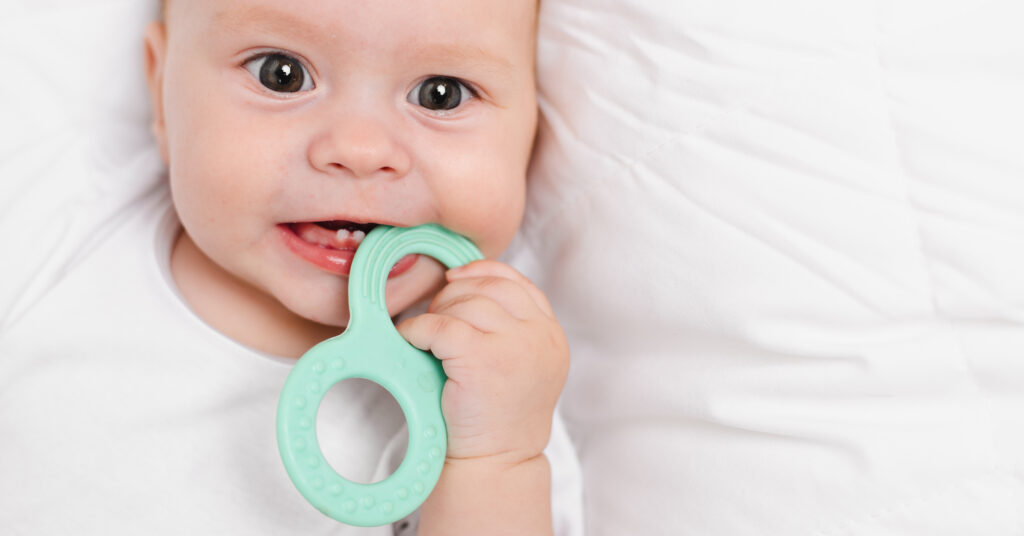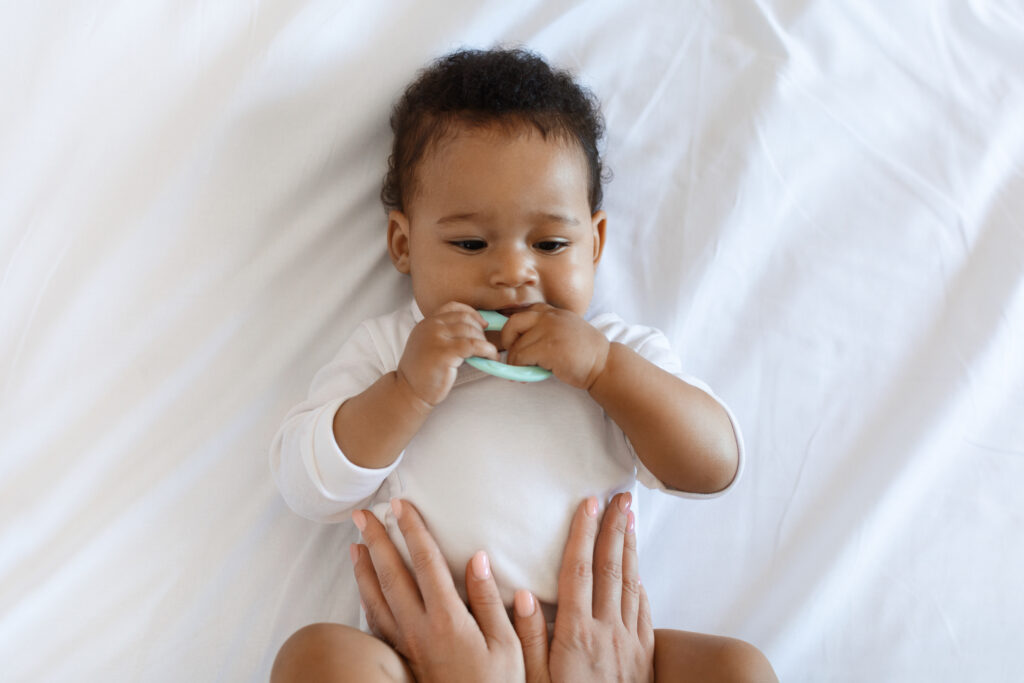Teething is an inevitable and healthy part of your baby’s development — but it can be a nerve-wracking time for parents as their little ones struggle through cutting those first few teeth.
A fussy baby who’s teething can be hard to calm — no matter the time of day. During the day, you expect to be awake, and distraction from daily activities can actually help a teething baby ignore their sore and irritable gums. But nighttime can be an entirely new challenge.
So, what can you do to soothe your little one and get them back to bed, so the both of you can enjoy some shut-eye? Here are some tips from your doctors at Partners in Pediatrics and sleep experts at Rested Kids!
What is “Teething”?
“Teething” refers to the process of a baby’s first teeth migrating from deep within the gums to the surface. “Cutting teeth” is the act of a tooth erupting through the gum tissue. Teething typically occurs between ages 3 months to 1 year for most children, though that can vary by child. There are no visible changes in the gums, so predicting when teething will begin is difficult.
You may notice that your generally happy baby may suddenly experience periods of crabbiness, irritability, excessive drooling, and putting everything in their mouth — these are the tell-tale signs of teething.
Mild inflammation of the gums may occur, which can cause other symptoms such as low fever (no greater than 101 degrees), mild diarrhea, runny nose, lose of appetite, and sleep deprivation.
As many parents can attest, the symptoms of teething can make babies extremely fussy. This irritability usually gets worse during naps and bedtime, when babies don’t have their typical daytime distractions.
Managing Sleep While Teething
Sara Cuthbert, sleep expert and founder of Rested Kids, says, “As with everything related to sleep, do your best to keep some consistency to your approach.” Whatever safe sleep process works best for your family — whether that’s independent sleep, co-sleeping, or any variation in between — the key is safety and consistency.
Of course, you need to tend to your baby or child’s needs, but it’s important to keep in mind that too much disruption or increased engagement during sleep-time can cause confusion for your little one and potential (though temporary) regression in their sleep patterns.
When your baby’s having a tough time teething, they may be extra fussy or clingy. Go ahead and offer extra snuggles to help comfort your baby.
However, do try to stick to your regular bedtime routine as much as possible. Veering away from normal sleep patterns — e.g., by offering lots of extra assistance falling asleep — can lead to the development of new sleep onset associations. These can disrupt sleep even once the teething is over.
Getting Back on Track
It’s possible that your little one will get off track with his/her sleep because of the changes in the routine. That’s okay! The first priority during teething or illness is to ensure your little one is getting sleep as it’s such a key to the recovery and healing processes.
Once your child is feeling better, or the effects of teething do not appear to be disrupting sleep, approach the next few days as a “reset” of your established sleep habits. If your child slept independently (without your regular intervention) before the extra support during teething, consider this approach to get back on track.
Continue with your established pre-bedtime routine and then let your child get to sleep on his/her own. If, because of the recent experience of intervention, there is upset or protest, try to go in your child’s room for 1 minute about every 10-15 minutes to offer some comfort and then leave again to let them do the work of getting to sleep independently.
Keep in mind that if this “leave and check” process increases the upset, it is helpful to space out the periods of comfort. If your child has the skills of independent sleep (sleep without needing your help – i.e. rocking, nursing, laying together, etc.) sleep will likely re-regulate in a few days when you get back to your normal approach.
If there are nighttime wakings, it can be helpful to wait 10 minutes before engaging as most infants and children with these skills will go back to sleep during that time as they are shifting between sleep cycles.
Note: These suggestions are based on independent sleep strategies. If you have a different sleep approach, please feel free to consult with your doctor for additional help.
Tips for Teething Pain Relief
The primary goals while working through teething are to manage discomfort, maintain good hydration, and to preserve sleep. There are countless ways (including some very not-recommended old wives’ tales) to help your little one relieve their pain. Below is a list of safe remedies. Any combination of the following may be required to achieve comfort for your kiddo.
Cold Therapy
One of the best home remedies for baby teething at night is to give cold items, which can numb your baby’s gums and may alleviate some of the pain.
- Chill a clean, damp washcloth in the freezer and use it to gently massage your baby’s gums with a clean finger.
- Fill a baby mesh feeder with frozen baby food or an ice cube and offer it to your baby to chew on.
- If your child is 6 months or older and has begun eating solids, try letting them chew on a soft bagel or chilled fruit such as melon or banana. Make sure the pieces are in large chunks to prevent choking.
- Put their favorite teether in the freezer for a few minutes to chill it before your baby gnaws on it.
Rash Prevention
Drooling is a natural and common symptom of teething. The problem? All that extra moisture can cause an uncomfortable rash on your baby’s skin. Here are some tips to prevent or manage your baby’s drool rash:
- Use a soft bib to gently wipe away excessive drool.
- Use an ointment such as petroleum jelly or Aquafor to create a protective barrier on your baby’s skin.
- Avoid soaps, lotions, and laundry detergents with harsh chemicals, including fragrances that could further irritate your baby’s delicate skin.
- Watch for signs of infection. If your baby’s skin begins to crack, weep puss, or bleed, call your integrative pediatric health care provider.
Use distraction
Sure, distraction won’t make your baby’s gums stop hurting, but it can keep their minds occupied on something else, which might help calm them down enough to sleep. Here are a few ideas to try while your baby chews on something safe, like a chilled teether.
- Draw a warm bath.
- Gently rock or bounce your baby.
- Use white noise like a vacuum, running water, white noise machine, or soft music.
- Sing or hum softly to your baby.
- Touching your baby can be soothing to them, so consider holding them close in your arms or a carrier, gently rubbing their skin, or even doing some infant massage.
Over-the-counter medications
If home remedies for teething aren’t cutting it and your baby is really struggling with teething discomfort at night, ask your pediatrician about giving your child an over-the-counter pain medication like infant acetaminophen or ibuprofen. For proper dosage instructions, reference our guide in the Naturally Healthy Kids handbook.
Practices to Avoid
Many products sold for teething pain don’t work—and some can even hurt your baby. For the safety of your little ones, we recommend avoiding the following products and practices:
- Teething necklaces. Though they look cute and can seem practical, necklaces present a significant strangulation and choking hazard for babies and should not be worn.
- Frozen teething rings. Teething rings should be stored in the refrigerator and be made of firm rubber. Rings that are hard plastic or frozen solid in freezer can damage soft, baby gums.
- Topical gels. Over-the-counter teething gels, such as Orajel®, are generally ineffective because drooling washes them out of your baby’s mouth very quickly. Also, they expose your infant to the topical anesthetic, benzocaine — a numbing ingredient. Benzocaine may actually numb the throat in addition to the gums and may make it difficult for your child to handle his own saliva.
- Teething tablets. Some tablets contain belladonna, which is toxic in high enough dosages.
Conclusion
Navigating the challenges of a teething baby’s discomfort requires a thoughtful approach that addresses both pain and sleep difficulties. By combining soothing remedies with proven sleep strategies, parents can create a holistic approach to alleviate their little one’s distress.
Patience and understanding play crucial roles in this process, as teething is a temporary phase that requires supportive care. As caregivers, it’s essential to tailor solutions to the unique needs of each baby, recognizing that a combination of comfort measures and sleep techniques can pave the way for both a more peaceful rest for the baby and a more tranquil experience for the entire family.
At Partners in Pediatrics, we are holistic pediatricians and pediatric health care providers committed to educating the mile high city with functional wellness and health care topics. We are dedicated to providing your family with exceptional pediatric care using a holistic approach – combining conventional medicine, holistic and homeopathic treatments, and alternative remedies.
Please get in touch with our team of integrative pediatricians with any questions about teething. If you’re in need of more comprehensive advice, please contact our team serving the Denver metro area, Littleton, City Park, Cherry Creek, downtown Denver, and the surrounding areas of Colorado.
Special thanks to Sara Cuthbert of Rested Kids — one of Denver’s pediatric sleep specialists, working with children from birth through adolescence since 2018.






Leave a Reply